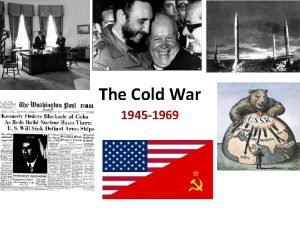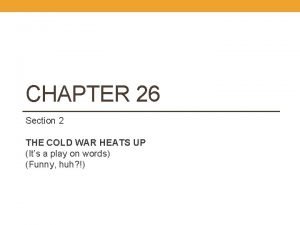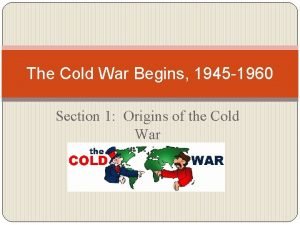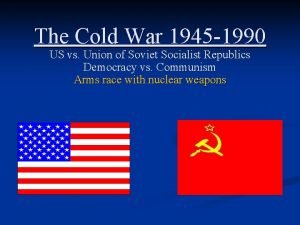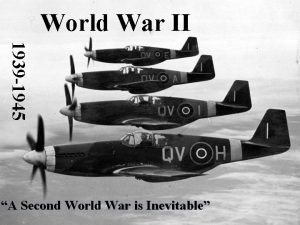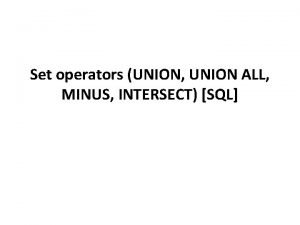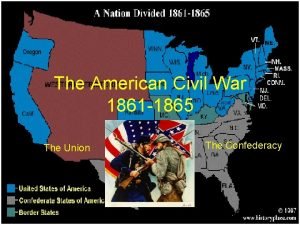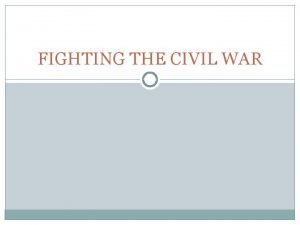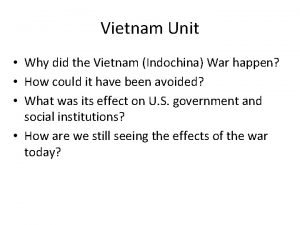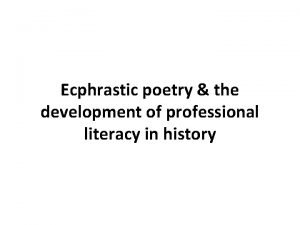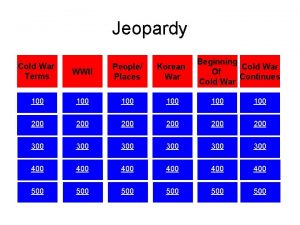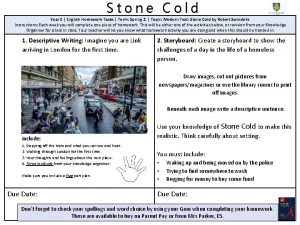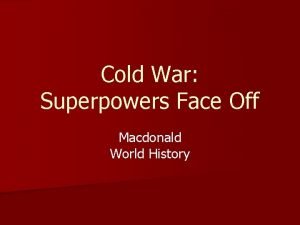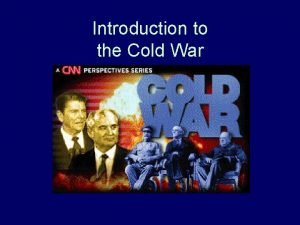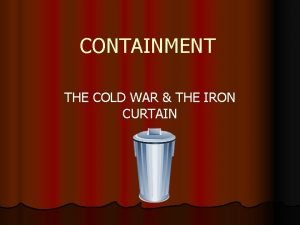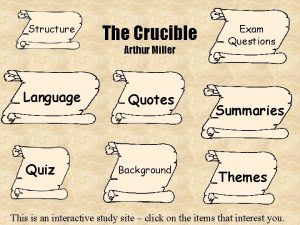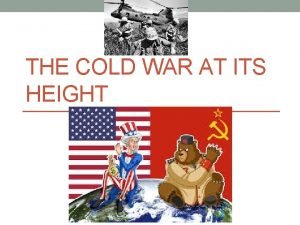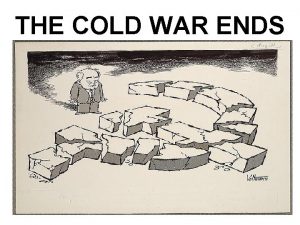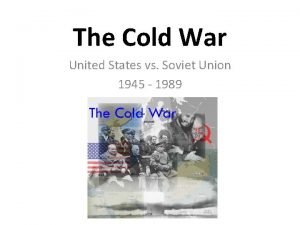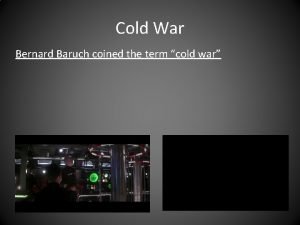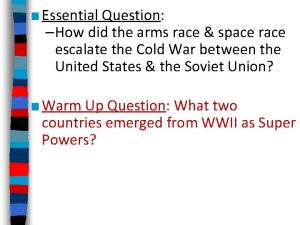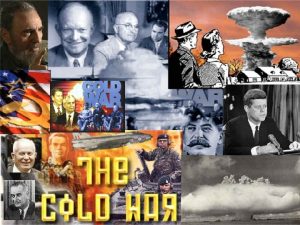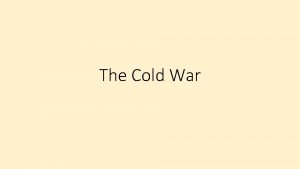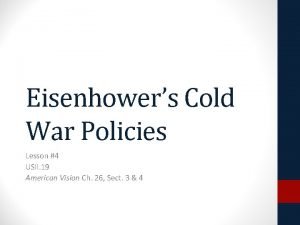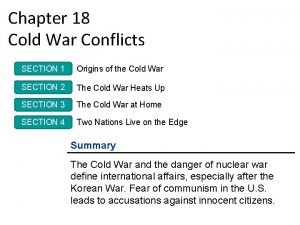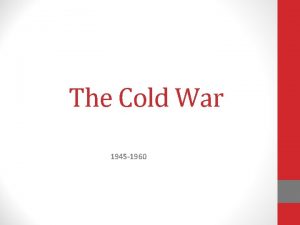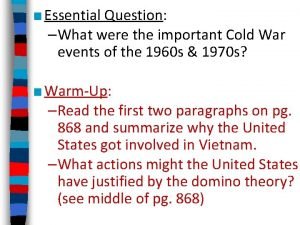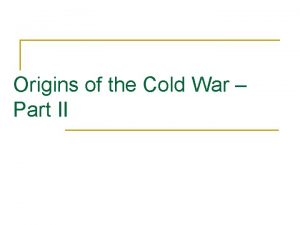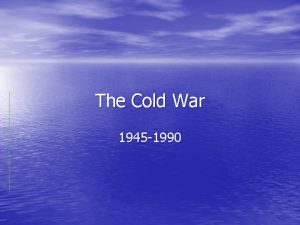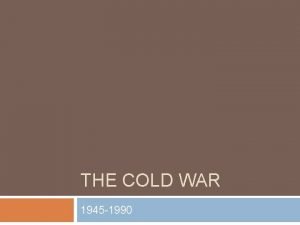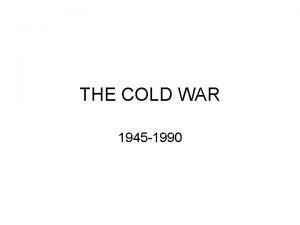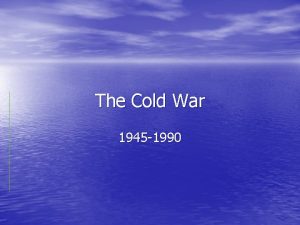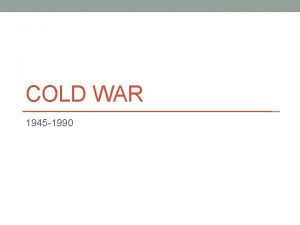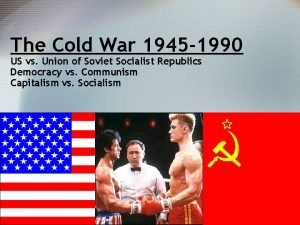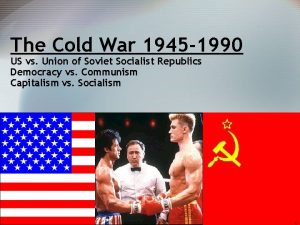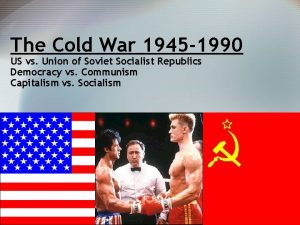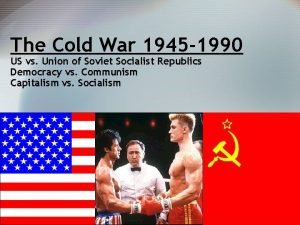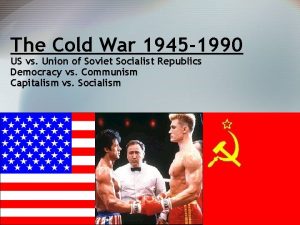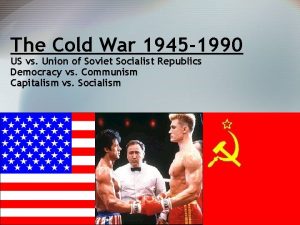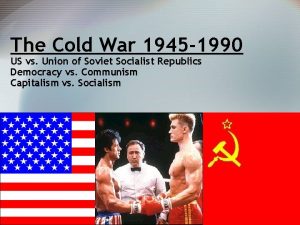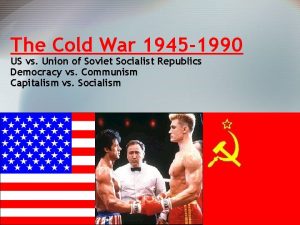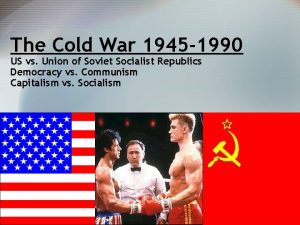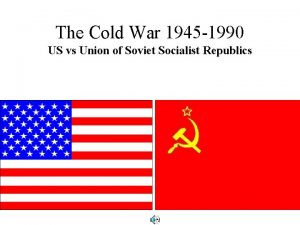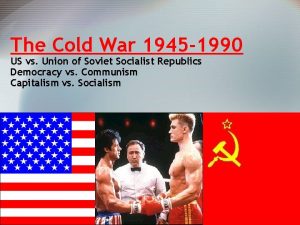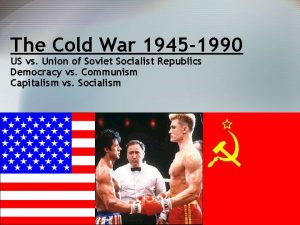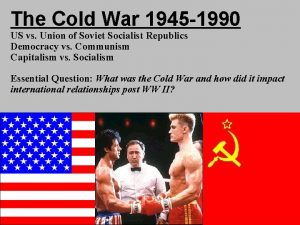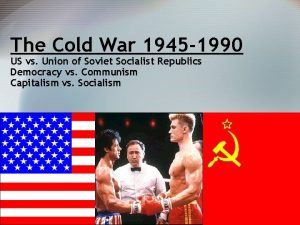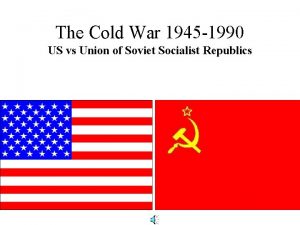THE COLD WAR 1945 1990 US VS UNION
































- Slides: 32

THE COLD WAR 1945 -1990 US VS. UNION OF SOVIET SOCIALIST REPUBLICS DEMOCRACY VS. COMMUNISM CAPITALISM VS. SOCIALISM 1

Origins of the Cold War � The cold war began with mistrust between the Soviet Union (red) and the western democracies (blue).

After World War 2 the Cold War began and caused tension throughout the world. � � The USA and the USSR were the two world Superpowers. The USA was a capitalist society with a democracy. The USSR was a communist country with a dictatorship. Both wanted to be the most powerful nation in the world.

US/USSR Relationship during WWII � 1. 2. 3. 4. Before the end of the World War II, Stalin, Churchill and Roosevelt met at Yalta to plan what should happen when the war ended. They agreed on many points: The establishment of the United Nations Division of Germany into four zones Free elections allowed in the states of Eastern Europe Russia’s promise to join the war against Japan Winston Churchill (England), Franklin Roosevelt (US) and Joseph Stalin (USSR) meet in Yalta in 1945 to decide the fate of post-war Europe. No agreement was reached on Poland. 4

Decisions at Yalta � � The physical structure of the cold war was put into place at the end of World War II. Winston Churchill, Franklin Delano Roosevelt and Joseph Stalin agreed in February of 1945 at Yalta to divide Germany into four occupation zones. Map of Berlin divided into zones after WWII

Post WWII/Cold War Goals for US �Promote open markets for US goods to prevent another depression �Promote democracy throughout the world, especially in Asia and Africa �Stop the spread of communism � “Domino Effect” 6

� Create Post WWII/Cold War Goals for USSR greater security for itself �lost tens of millions of people in WWII and Stalin’s purges �feared a strong Germany � Establish defensible borders � Encourage friendly governments on its borders � Spread communism around the world Excerpt from Winston Churchill’s “Iron Curtain Speech. ” “From Stettin in the Baltic to Trieste in the Adriatic an iron curtain has descended across the Continent. Behind that line lie all the capitals of the ancient states of Central and Eastern Europe. Warsaw, Berlin, Prague, Vienna, Budapest, Belgrade, Bucharest and Sofia, all these famous cities and the populations around them lie in what I must call the Soviet sphere, and all are subject in one form or another, not only to Soviet influence but to a very high and, in some cases, increasing measure of control from Moscow. ” 7

Soviet Influence in Eastern Europe � It was agreed that the Soviet Union would have the greatest influence in eastern Europe, where Soviet troops were concentrated. � They already occupied Poland, Bulgaria, Romania, Hungary and parts of Czechoslovakia and Yugoslavia, and it would have been difficult to come to an agreement which involved removing these troops. � Roosevelt agreed because he had little choice.

Truman Doctrine � � In 1947 The United States responded to what appeared to be a clear Soviet attempt to spread communism into Eastern Europe. It declared the Truman Doctrine aimed at stopping the further spread of communism. Help should be primarily through economic and financial aid

Marshall Plan �In 1947, US Secretary of State Marshall announced the Marshall Plan. � This was a massive economic aid plan for Europe to help it recover from the damage caused by the war. � There were two motives for this: �Helping Europe to recover economically would provide markets for American goods, so benefiting American industry. �A prosperous Europe would be better able to resist the spread of communism. This was probably the main motive. Secretary of State George Marshall. A poster promoting the Marshall Plan 10

* The U. S. gave over $12 billion in aid to European countries between 1948 and 1952, helping to improve their economies and lessen the chance of communist revolutions.

The Berlin Crisis: June 1948 -May 1949 � 1948: three western controlled zones of Germany united; grew in prosperity due to the Marshall Plan �West wanted East to rejoin; Stalin feared it would hurt Soviet security. �June 1948: Stalin decided to gain control of West Berlin, which was deep inside the Eastern Sector �Cuts road, rail and canal links with West Berlin, hoping to starve it into submission �West responded by airlifting supplies to allow West Berlin to survive �May 1949: USSR admitted defeat, lifted blockade Map of Berlin divided into zones after WWII Map of Germany divided into zones after WWII A plane flies in supplies during the Berlin Airlift. 12

NATO: North Atlantic Treaty Organization �In 1949 the western nations formed the North Atlantic Treaty Organization to co-ordinate their defense against USSR. � It originally consisted of: � America � Belgium � Britain � Canada � Denmark � France � Holland � Italy � Luxembourg � Norway � Portugal �Since NATO flag the fall of the Soviet Union in 1991, some former Soviet republics have applied for membership to NATO. 13

� Warsaw Pact: organization of communist states in Central and Eastern Europe. � Established May 14, 1955 in Warsaw, Poland � USSR established in in response to NATO treaty � Founding members: � Albania (left in 1961 as � Bulgaria � Czechoslovakia � Hungary � Poland � Romania �USSR � East Germany (1956) a result of the Sino-Soviet split) Greatest extent of Warsaw Pact 14

Mao Tse Tung • Mao Tse Tung, defeats Chang Kai Shek in the Chinese Civil War…. . • China became a communistic country. • Chang Kai Shak is exiled to Taiwan. • Mao Tse Tung becomes the Communistic leader of China. • US believed there was a communistic plot to rule the world NATO Chang Kai Shek

• 1950 to 1953, North Korea invades South Korea. • North Korea was a communist nation and South Korea was a democracy. • First war of “containment” policy to stop communism • “Police Action” not a declared war • President Truman leads United Nations. • General Douglas Mac. Arthur commands US and UN troops. • Called “forgotten war”.

• Stalemate by 1953. • Pres. Eisenhower negotiated an end to war • Divided at 38 th parallel • Communism contained • Remains divided today

Arms Race • Cold War tensions increased in the US when the USSR exploded its first atomic bomb in 1949. • Cold War tensions increased in the USSR when the US exploded its first hydrogen bomb in 1952. It was 1000 times more powerful than the Hiroshima atomic bomb. 18

Space Race • Cold War tensions increased in the US when the USSR launched Sputnik I, the first artificial satellite into geocentric orbit on October 4, 1957. – The race to control space was on. • April 12, 1961: Yuri Gagarin became first human in space and first to orbit Earth. • US felt a loss of prestige and increased funding for space programs and science education. • On May 25, 1961, Kennedy gave a speech challenging America to land a man on the moon and return him safely by the end of the decade. • Apollo 11 landed on the moon on July 16, 1969. 19

The U-2 Incident �USSR was aware of American U-2 spy missions but lacked technology to launch countermeasures until 1960. � May 1, 1960: CIA agent Francis Gary Powers’ U 2, was shot down by Soviet missile. �Powers was unable to activate plane's selfdestruct mechanism before he parachuted to the ground, right into the hands of the KGB. �When US learned of Powers' disappearance over USSR, it issued a cover statement claiming that a "weather plane" crashed after its pilot had "difficulties with his oxygen equipment. " US officials did not realize: �Plane crashed intact, �Soviets recovered its photography equipment �Captured Powers, whom they interrogated extensively for months before he made a "voluntary confession" and public apology for his part in US espionage 20

The Bay of Pigs Invasion � The Bay of Pigs Invasion was an unsuccessful attempt by US-backed Cuban exiles to overthrow the government of the Cuban dictator Fidel Castro. �Increasing friction between the US and Castro's communist regime led President Eisenhower to break off diplomatic relations with Cuba in January 1961. �Even before that, however, the CIA had been training anti-revolutionary Cuban exiles for a possible invasion of the island. � The invasion plan was approved by Eisenhower's successor, John F. Kennedy. 21

The Bay of Pigs Invasion… � On April 17, 1961 about 1300 exiles, armed with US weapons, landed at the Bahía de Cochinos (Bay of Pigs) on the southern coast of Cuba hoping for support from locals. � From the start, the exiles were likely to lose. Kennedy had the option of using the Air Force against the Cubans but decided against it. � Consequently, the invasion was stopped by Castro's army. The failure of the invasion seriously embarrassed the Kennedy administration. � Some critics blamed Kennedy for not giving it adequate support � Others blamed Kennedy for allowing it to take place at all. � Additionally, the invasion made Castro wary of the US He was convinced that Americans would try to take over the Cuba again. Cuban leader Fidel Castro watches events during the Bay of Pigs Invasion. 22 the

Berlin Wall �In the dark on August 13, 1961, a low, barbed-wire barrier rose between East and West Berlin. Within days, workers cemented concrete blocks into a low wall, dividing neighborhoods and families, workers and employers, the free from the repressed. �The USSR called the wall a barrier to Western imperialism, but it also was meant to keep its people going to the West where the standard of living was much higher and freedoms greater. �The West Germans called it Schandmaur, the "Wall of Shame. " Over the years, it was rebuilt three times. Each version of the wall was more higher, stronger, repressive, and impregnable. Towers and guards with machine guns and dogs stood watch over a barren no man's land. Forbidden zones, miles wide, were created behind the wall. No one was allowed to enter the zones. Anyone trying to escape was shot on sight. Early 1960 s view of east side of Berlin Wall with barbed wire at top. A view from the French sector looking over the 23 wall.

Cuban Missile Crisis CIA map showing range of Soviet supplied intermediate and medium range missiles if launched from Cuba � This was the closest the world ever came to nuclear war. The US armed forces were at their highest state of readiness ever, and Soviets in Cuba were prepared to launch nuclear weapons to defend the island if it were invaded. �In 1962, the USSR lagged far behind the US in the arms race. Soviet missiles were only powerful enough to be launched against Europe but US missiles were capable of striking the entire Soviet Union. �In April 1962, Soviet Premier Khrushchev deployed missiles in Cuba to provide a deterrent to a potential US attack against the USSR. �Meanwhile, Fidel Castro was looking for a way to defend his island nation from an attack by the US. Ever since the failed Bay of Pigs invasion in 1961, Castro felt a second attack was inevitable. Consequently, he approved of Khrushchev's plan to place missiles on the island. In the summer of 1962 the USSR secretly installed the missiles. 24

crisis began on October 15, 1962 when Cuban Missile Crisis… �The reconnaissance revealed Soviet missiles under From top: Castro, Kennedy, Khrushchev, and poster for a movie about the crisis called Thirteen Days construction in Cuba. �After seven days of intense debate within the White House, Kennedy imposed a blockade around Cuba to stop the arrival of more Soviet missiles. �On October 22, Kennedy announced the discovery of the missiles and his decision to blockade Cuba and that any attack launched from Cuba would be regarded as an attack on the US by the USSR and demanded that the Soviets remove all of their offensive weapons from Cuba. �October 27 was the worst day of the crisis. A U-2 spy plane was shot down over Cuba. �Tensions finally began to ease on October 28 when Khrushchev announced that he would dismantle the installations and remove the missiles, expressing his trust that the US would not invade Cuba. �Further negotiations were held to implement the October 28 agreement, including a US demand that Soviet bombers be removed from Cuba, and specifying the exact form and conditions of US assurances not to 25 invade Cuba.

The Slow Thaw… � In 1969 Nixon began negotiations with USSR on SALT I, common name for the Strategic Arms Limitation Treaty Agreement. �SALT I froze the number of ballistic missile launchers at existing levels, and provided for the addition of submarine-launched ballistic missile (SLBM) launchers only after the same number of intercontinental ballistic missile (ICBM) and SLBM launchers had been dismantled. �It was the first effort between US/USSR to stop increase nuclear weapons. �SALT II was a second round of US/USSR talks (1972 -1979), which sought to reduce manufacture of nuclear weapons. SALT II was the first nuclear treaty seeking real reductions in strategic forces to 2, 250 of all categories on both sides. Nixon and Brezhnev toast the SALT I treaty. Carter and Brezhnev sign the SALT II treaty. 26

Vietnam War 1960 s-1973 � Through the Kennedy years, US troops trained S. Vietnamese troops to fight the Reds. � After the Gulf of Tonkin Resolution, under LBJ, US troops started to fight more.

Soviet Invasion of Afghanistan Interrupts Thaw �In 1978, the USSR invaded Afghanistan and tried to set up a friendly government. �It became the USSR’s Vietnam, a long war with no clear victory possible and many casualties and high costs. � The US supported the Afghani rebels known as the mujahideen. �In 1989 the Soviets finally withdrew. Islamic extremists used the opportunity to take over the country. �The defeat weakened the Soviet’s economy and morale. Movie poster for Charlie Wilson’s War about US efforts to support the mujahideen Muhahideen celebrate the downing of a Soviet helicopter 28

Reagan’s Star Wars Interrupts Thaw � The Strategic Defense Initiative (SDI) was a proposal by President Reagan on in 1983 to use ground and space-based systems to protect the US from attack by nuclear ballistic missiles. It focused on strategic defense rather than doctrine of mutual assured destruction (MAD). �It was quickly nicknamed “Star Wars. ” � Criticism of SDI: �It would require the US to change, withdraw from, or break earlier treaties. �The Outer Space Treaty of 1967, which requires "States Parties to the Treaty undertake not to place in orbit around the Earth any objects carrying nuclear weapons or any other kinds of weapons of mass destruction, install such weapons on celestial bodies, or station such weapons in outer space in any manner" and would forbid the US from pre-positioning in Earth orbit any devices powered by nuclear weapons and any devices capable of "mass destruction. “ � The program proposed to use unproven technology. � The program would cost many billions of dollars. �It would start a new arms race with the Soviets. Artist rendering of satellites and lasers to be used in SDI other 29

Cold War Thaw Continues � Gorbachev becomes Soviet premier and understands that the Soviet economy cannot compete with the West, partly because of Afghanistan and partly because of the costs of keeping up militarily. �Gorbachev recognizes there is increasing unrest in the country. �He tries to reform the USSR with glasnost (= openness: think “glass” because you can see through it) and perestroika (=restructuring: think “structure/stroika”). � Gorbachev is further pressured to reform the USSR when Reagan gives his speech in Germany challenging Gorbachev to “tear down this wall. ” Soviet Premier Mikhail Gorbachev President Reagan delivers his speech in Berlin. 30

The Wall Falls, 1989 �A wave of rebellion against Soviet influence occurs throughout its European allies. �Poland’s Solidarity movement breaks the Soviet hold on that country �Hungary removed its border restrictions with Austria. � Riots and protests break out in East Germany. �East Germans storm the wall. Confused and outnumbered, border guards do not fight back. �The wall is breached. �Eventually East and West Germany are reunited in 1990. 31

The USSR Dissolves �On Boris Yeltsin (far left) stands on a tank to defy the 1991 coup December 21, 1991, the presidents of Russia, Ukraine and Belarus signed the Belavezha Accords declaring the USSR dissolved and established the Commonwealth of Independent States (CIS) in its place. �On December 25, 1991, Gorbachev yielded as the president of the USSR, declaring the office extinct. He turned the powers that until then were vested in him over to Boris Yeltsin, president of Russia. � The following day, the Supreme Soviet, the highest governmental body of the Soviet Union, recognized the collapse of the Soviet Union and dissolved itself. �This is generally recognized as the official, final dissolution of the Soviet Union as a functioning state. Rocky beats Ivan Drago. 32
 The cold war lesson 1 the cold war begins
The cold war lesson 1 the cold war begins The cold war heats up: 1945 - 1969
The cold war heats up: 1945 - 1969 Chapter 26 section 2 the cold war heats up
Chapter 26 section 2 the cold war heats up The cold war begins 1945-1960
The cold war begins 1945-1960 1990-1945
1990-1945 Cold war proxy
Cold war proxy 1945 world war ii
1945 world war ii 1945 world war
1945 world war Union union all intersect
Union union all intersect The union blockade during the civil war
The union blockade during the civil war Civil war union strategy
Civil war union strategy Operation rolling thunder cold war
Operation rolling thunder cold war Image
Image Jeopardy cold war
Jeopardy cold war Stone cold war
Stone cold war History of cold war
History of cold war Conclusion of cold war
Conclusion of cold war Iron curtain containment
Iron curtain containment Structure of the crucible
Structure of the crucible Cold war height
Cold war height Expansionism cold war
Expansionism cold war Cold war
Cold war The cold war thaws worksheet answers
The cold war thaws worksheet answers Domino theory
Domino theory Inner party 1984
Inner party 1984 Why did the arms race escalate during the cold war
Why did the arms race escalate during the cold war Comunist map
Comunist map Was the cold war capitalism vs communism
Was the cold war capitalism vs communism Lesson 4 eisenhower's cold war policies
Lesson 4 eisenhower's cold war policies Origins of the cold war chapter 18 section 1
Origins of the cold war chapter 18 section 1 Cold war summary
Cold war summary Brinkmanship cold war
Brinkmanship cold war Origins of the cold war
Origins of the cold war

